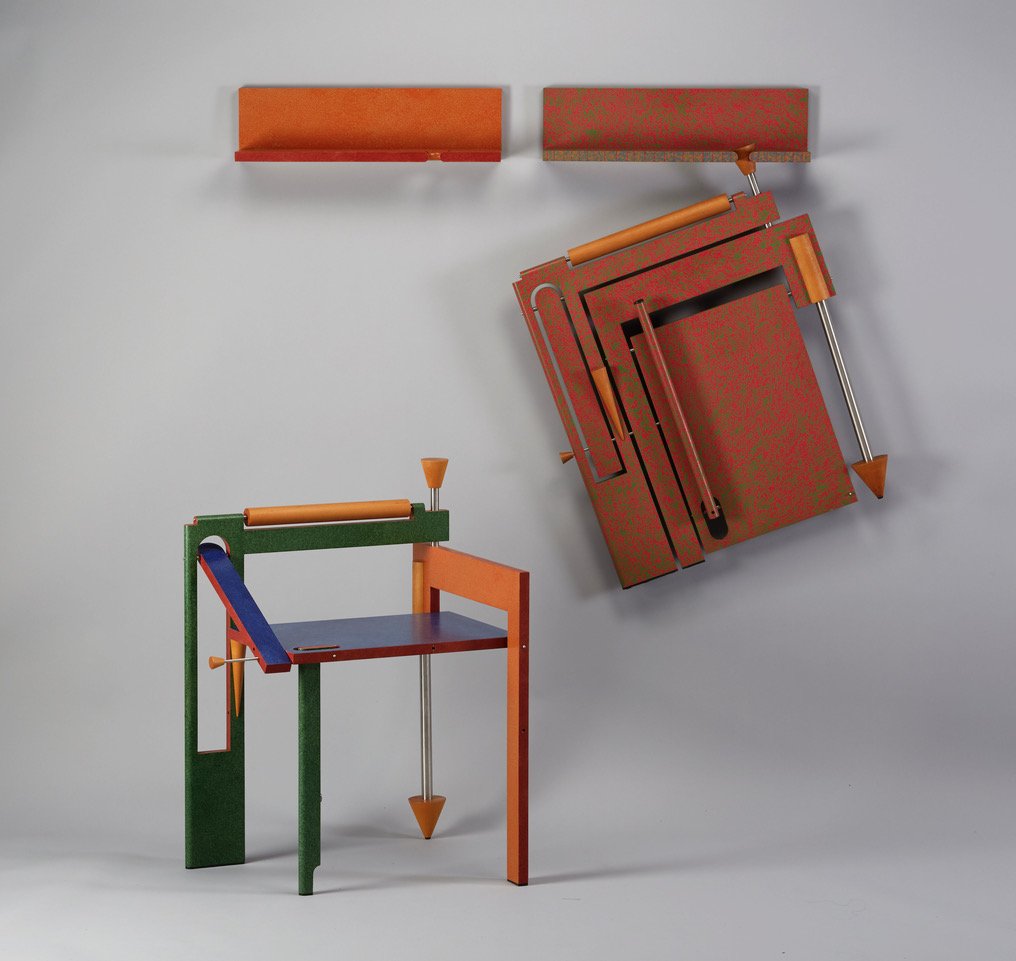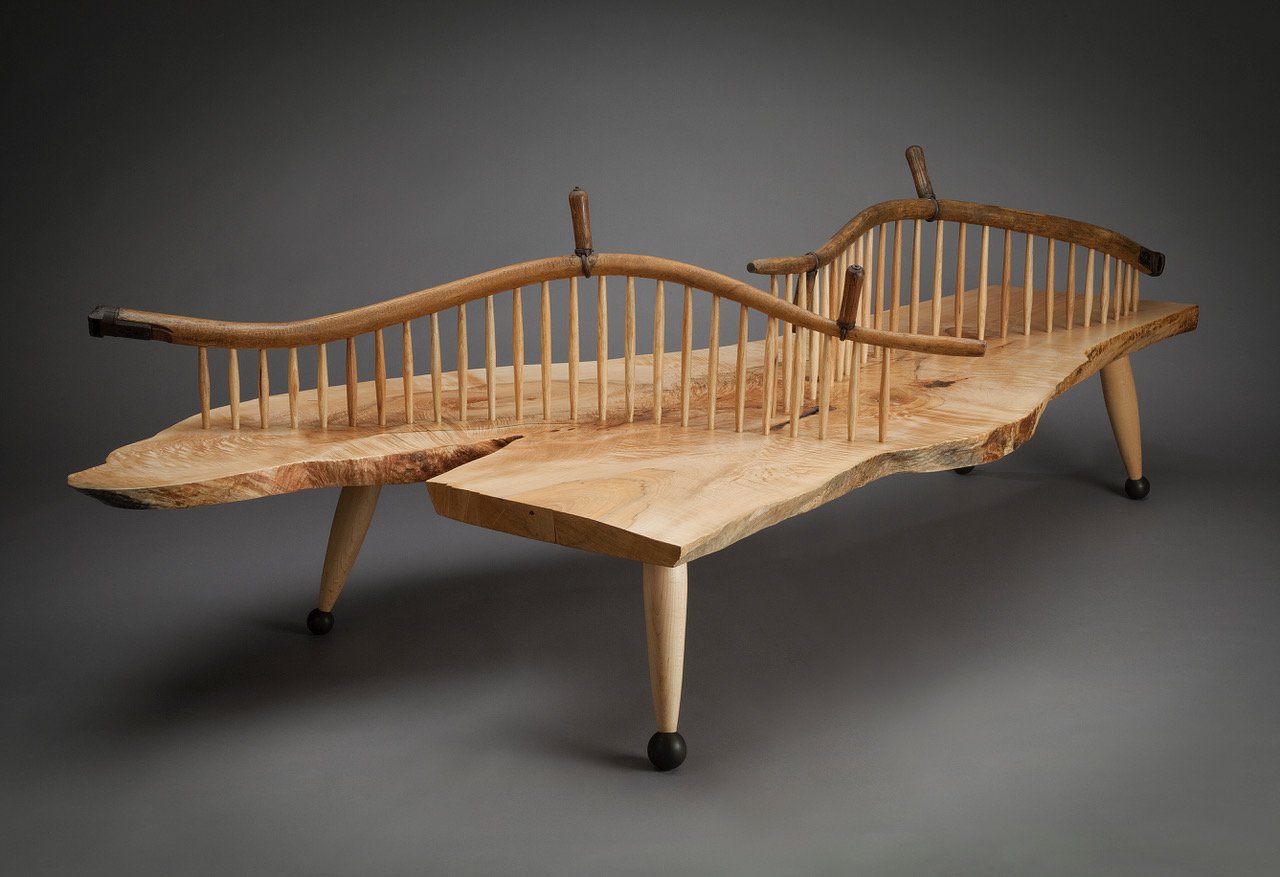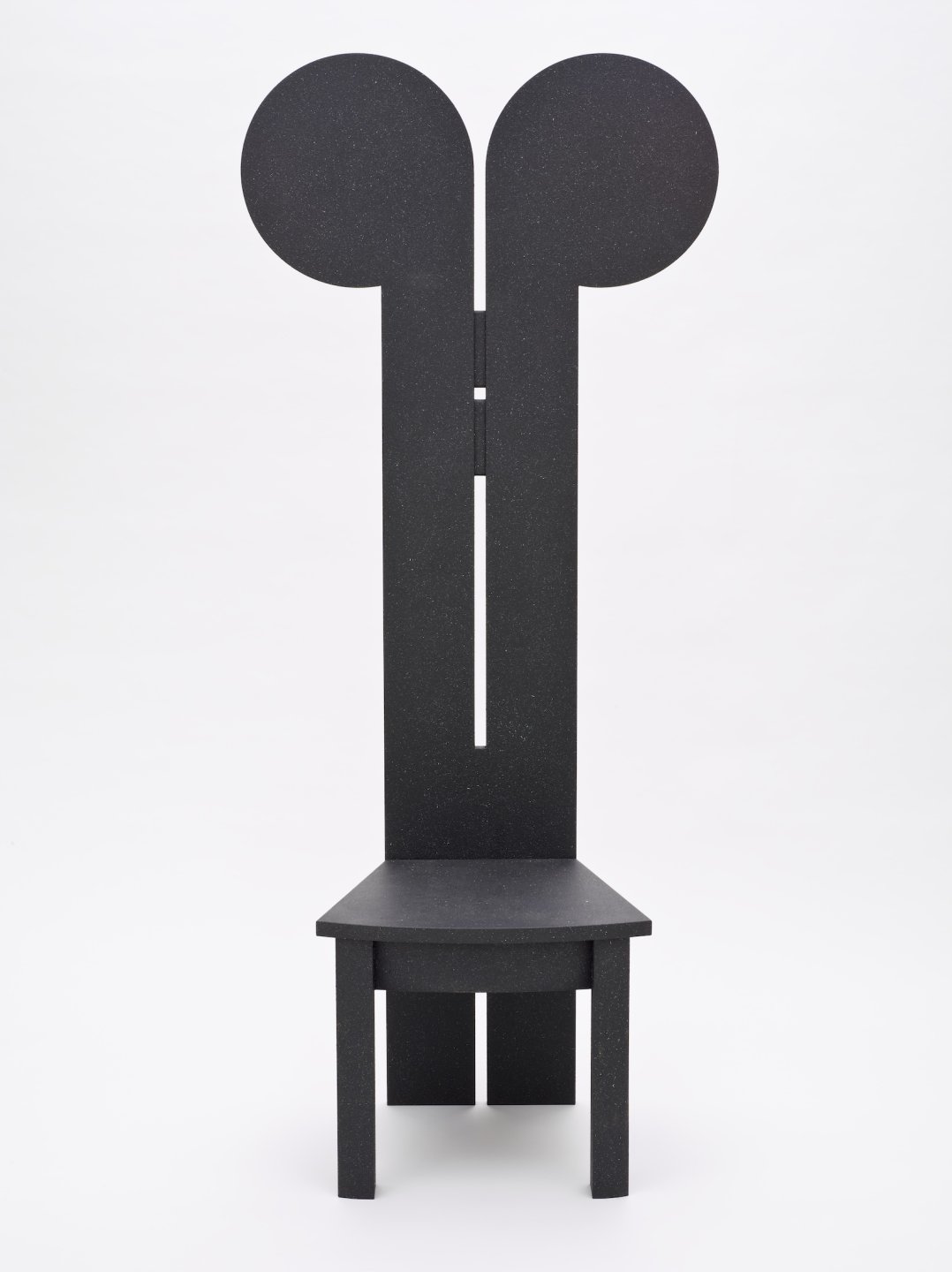
Can a chair be more than a place to sit? Might a cabinet offer more than storage? In the hands of Wendy Maruyama and Tom Loeser—celebrated artists, educators, and protagonists of the American Studio Craft Movement—furniture transcends function and becomes a catalyst that provokes, perplexes, and ultimately delights. Teeming with the post–World War II crafts movement’s playfulness and hand-hewn experimentation in abstract sculptural forms and nontraditional techniques and materials, their one-of-a-kind pieces confound our relationships with objects and one another, by design.
Maruyama and Loeser are nothing short of legends in the realm of woodcraft. Maruyama, 72, is among the first women in the United States to pursue woodworking as a profession. Loeser, 68, is renowned for impeccably engineered furniture pieces that toe the line between function and dysfunction. Both of their work has been exhibited widely and is included in the collections of major museums around the world.
Longtime friends, the two have influenced generations of makers over the course of their 30-odd-year tenures at San Diego State University and the University of Wisconsin, Madison, respectively. Now retired from teaching, they’re back in their workshops and making pieces for “Colorama,” a joint exhibition—their first together—opening at New York’s Superhouse gallery on November 14 (through January 11, 2025).
Stephen Markos, the gallery’s founder and curator, says that the duo’s sustained experimentation in “art furniture” is thrilling to witness. “They’re complete vanguards in this field,” he says. “Having them create these new bodies of work lets us see where they are in the arc of their long careers that are still going. I’m interested in what they’re interested in now.”
It turns out that Maruyama is still very much obsessed with purposeful niches. She’s currently working on a triptych of partitioned cabinets to house items like “bottles of perfume, tequila, jewelry, or medication,” as she suggests. And Loeser is ever fascinated with how chairs shape power dynamics. “I’m interested in how seating can organize, influence, and structure social relations,” he says, citing a series of whimsical double rocking chairs that require two people to stay balanced, and a public bench where sitters must negotiate a moving backrest.
Ahead of their New York exhibition, I spoke with Maruyama and Loeser about their tools, teaching, and the place of the handmade artifact during a tech-obsessed era.

ANNE QUITO: What do younger generations need to understand about craft? Are there universal skills gleaned from the act of making things by hand?
WENDY MARUYAMA: Craft is central to all types of making, not just wood or textiles. There is craft in cooking, painting, sculpting; anything that is “made” is craft. One of my former students and fellow woodworker just bought a house and planted all native plants in her yard. She’s learning to extract color pigments from them and is making her own inks and colors for art making. That is craft.
TOM LOESER: As culture becomes more technological, the original “digital” skills embedded in craft are becoming rarer, and thus more valuable. There is insanely inspirational creativity in the electronic realm, but a different part of your mind is engaged when figuring out how to build a piece of furniture. The troubleshooting and problem-solving in the workshop often involves trying a certain tool or technique, and then adjusting as needed. There is a very direct feedback loop from the hand to the visual result. This offers a different sort of satisfaction and reward.
The special set of craft skills is also fully transferable to non-craft realms. Knowing how to make things and how to solve challenges with hand/brain skills is a special skill set to have in your toolbox.
AQ: It struck me that the American Studio Craft Movement began during an era of mass production, which is somehow akin to the current era of mass creation propelled by the rise of generative artificial intelligence. How do you feel about AI’s promise, or encroachment, in the arts?
WM: I don’t know enough about AI as it could pertain to craft, for the same reason I don’t understand NFTs. If I can’t touch it, hold it, or use it, what is it?
But as far as digital tools go, when they first came out, it was kind of a big deal. Artists were using these computer-assisted machines to “carve” objects that would otherwise be so time-consuming and hard—and the result had that “wow” factor, too. But now I have grown to the point that I see the CNC machine or the laser cutter as simply a means to an end. It’s a time-saver.
TL: When I first started doing woodworking, I was worried that crafting functional objects wasn’t a very relevant or important activity in contemporary culture. Why was I doing it, and why was I enthusiastically teaching these archaic skills? However, as most everything became more digital, craft and making things by hand became more unusual, and thus, more important.
How AI will change the creative arts is evolving crazy fast. It feels like AI may be a huge change that will permanently alter sectors of the creative world. But if it follows the same path as other recent electronic innovations, it will finally evolve into another tool in the creative-arts toolbox. Like any tool, it still needs to be used well, and the critical capabilities of skilled artists are still going to get far superior results.

AQ: I’m curious about your relationship with your primary tools—your hands.
WM: It’s funny that you ask this. At my relatively youthful age—ha—I am finding that I don’t have the dexterity that I used to. I was also born with a touch of cerebral palsy, which sometimes affects my motor control and involuntary movements, but I think working with my hands has actually kept that in control. I found that the more you use your hands or body, the better.
But one can always adjust. I can’t carry around a three-quarter inch thick sheet of plywood by myself anymore, but I am working with lighter and thinner materials. When I wanted to make a life-size elephant head [for the 2017 exhibition “Wendy Maruyama: The wildLIFE Project” at San Francisco’s Museum of Craft and Design], I used thin sheets of jelutong, a very light hardwood, and string to tie together pieces to make the large form. I was able to move the thing around without any help because I could just fold it up and carry it. Maybe someday, when I can’t really use the tools like I used to, I’ll be like Henri Matisse and cut colored paper in bed.
TL: When it works well, the hand and brain build on each other. The brain has a partially formed idea, then the hand offers up 3-D possibilities, and a conversation starts. Also, I get stuck a lot, usually because I’m unsure if an idea is worthwhile. Hands can get things going again. Sometimes it might just take spending a day or an afternoon doing something repetitive and satisfying in the workshop. It might be carving or painting or a joinery experiment that nibbles around the edges of the current stumbling block. It might be not directly connected, but it still offers some lateral movement that ends up being helpful.
AQ: What role did teaching play in your practice?
WM: One of the things I really loved about challenges from students is that they would come up with designs that, at first glance, I would say, “That’s impossible. It breaks all the tenets of what woodworking should be.” Then they would say, “Why not?”And I would step back and think, Yeah, why not?! Then we would think of a way to make it work.
Teaching also kept my finger on the pulse of what was going on in the field and made me stay on top of the latest in the design, fine arts, and craft. I am grateful for all of that.
TL: Teaching is drinking from a firehose of ideas, questions, techniques, and exposure to both unfinished and resolved work. This contrasts completely with working solo in my own studio, looking at the current project day after day. A teaching day is exhausting, but it is also a stimulant that makes the next chance to get into my own studio more special and charged. To be honest, I think I might have gotten bored just going to my own studio and being stuck with myself all day.
A kind of curious mental carryover from teaching sometimes shows up when I’m developing an idea or a design. I ask myself what sort of grade would I give my project if I wasn’t the maker, and instead a student submitting it for a class project. If it is drifting down towards a C+, maybe it needs a rethink or a full tear-down and redirect. One of the core goals of teaching is to cultivate a self-criticality and an ability to combine the spontaneous parts of the creative practice with an analytical eye and an intellectual dialogue. That core critique process is a super valuable tool to bring to my own studio work.
AQ: During a time when we’re challenged to have fewer and better things, can you tell me about a piece of furniture you treasure most?
WM: Growing up our family was sort of poor, so we always had second-hand furniture and there is nothing really notable about what we had. But I had an aunt who had a great style, and in the 1950s she had a butterfly chair, which I thought was so cool. I also remember her rattan sofa and chair set that had this Hawaiian-type fabric with fringe—so cool!
As far as furniture I made, I don’t own any of my favorite pieces. The ones I do have and like the most are the blanket chests and cabinets. I have so much stuff, so these things are just filled to the gills with things I managed to collect over the past fifty years.
TL: I have a chair made by Brian Boggs at the first Furniture Society conference in 1997 in Purchase, New York. Brian built the walnut chair over the three days of the conference, then auctioned it to benefit the Furniture Society.
It is a simple walnut stick chair with some beautiful bent parts, and wonderful proportions and details. Looking at the chair, one might not expect it to be all that comfortable, but there is a magical moment whenever I sit in the chair, even after owning it for twenty-seven years, when it just fits perfectly. I sit on this chair multiple times every day, and every time I admire its blend of function with a resolved and understated aesthetic.

AQ: Thinking of each other’s bodies of work, what piece of furniture would you like to own?
WM: Without a doubt I have to say the chest of drawers with a ton of drawers in it [called “Multiple Complications” (1995)]. The number of drawers is one thing, but the colors in Tom’s work are so fantastic too. I’ve always loved that piece. It’s a piece I can stash a lot of stuff in!
TL: I’ll take a full set of “Mickey Mackintosh” chairs (1981), please. Anyone studying furniture-making will, at some point, discover Charles Rennie Mackintosh’s amazing chair designs. They are a real problem because there is no possibility in the world that you could out-Mackintosh Mackintosh to design a chair that can compete with the proportions, striking form, and line quality of his work.
Yet Wendy’s “Mickey Mackintosh” finesses the situation through a sublime and humorous mash-up of reverence for the art-historical brilliance of Mackintosh and her love for popular culture, especially as filtered through the worldview of Southern California. “Mickey Mackintosh” looks simple, but it’s not. It can only be the creation of an artist with Wendy’s big-picture perspective of how seemingly disparate elements and inspirations can coexist and cohere to make a totally new statement.
Maruyama and Loeser will talk about the work in their Superhouse exhibition “Colorama” with Untapped’s editor-in-chief, Tiffany Jow, on Friday, November 15, from 6:30 p.m. to 8 p.m. at Index (120 Walker Street, 3rd Floor, New York, NY 10013). Visit the event website to learn more and to RSVP.
This conversation has been condensed and edited for clarity.